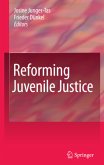- Broschiertes Buch
- Merkliste
- Auf die Merkliste
- Bewerten Bewerten
- Teilen
- Produkt teilen
- Produkterinnerung
- Produkterinnerung
Juvenile Justice: Redeeming Our Children debunks myths about juvenile justice in order to achieve an ideal system that would protect vulnerable children and help build safer communities. Author Barry Krisberg assembles broad and up-to-date research, statistical data, and theories on the U.S. juvenile justice system to encourage effective responses to youth crime. This text gives a historical context to the ongoing quest for the juvenile justice ideal and examines how the current system of laws, policies, and practices came into place.
Andere Kunden interessierten sich auch für
![Juvenile Justice Juvenile Justice]() Barry KrisbergJuvenile Justice177,99 €
Barry KrisbergJuvenile Justice177,99 €![Juvenile Crime and Justice Juvenile Crime and Justice]() Juvenile Crime and Justice95,99 €
Juvenile Crime and Justice95,99 €![Encyclopedia of Juvenile Justice Encyclopedia of Juvenile Justice]() Marilyn D. McshaneEncyclopedia of Juvenile Justice213,99 €
Marilyn D. McshaneEncyclopedia of Juvenile Justice213,99 €![Juvenile Justice Juvenile Justice]() Gus MartinJuvenile Justice136,99 €
Gus MartinJuvenile Justice136,99 €![Reinventing Juvenile Justice Reinventing Juvenile Justice]() Barry KrisbergReinventing Juvenile Justice95,99 €
Barry KrisbergReinventing Juvenile Justice95,99 €![Reforming Juvenile Justice Reforming Juvenile Justice]() Reforming Juvenile Justice75,99 €
Reforming Juvenile Justice75,99 €![Juvenile Justice Juvenile Justice]() Donald ShoemakerJuvenile Justice67,99 €
Donald ShoemakerJuvenile Justice67,99 €-
-
-
Juvenile Justice: Redeeming Our Children debunks myths about juvenile justice in order to achieve an ideal system that would protect vulnerable children and help build safer communities. Author Barry Krisberg assembles broad and up-to-date research, statistical data, and theories on the U.S. juvenile justice system to encourage effective responses to youth crime. This text gives a historical context to the ongoing quest for the juvenile justice ideal and examines how the current system of laws, policies, and practices came into place.
Hinweis: Dieser Artikel kann nur an eine deutsche Lieferadresse ausgeliefert werden.
Hinweis: Dieser Artikel kann nur an eine deutsche Lieferadresse ausgeliefert werden.
Produktdetails
- Produktdetails
- Verlag: Sage Publications, Inc
- Seitenzahl: 250
- Erscheinungstermin: 13. September 2004
- Englisch
- Abmessung: 229mm x 152mm x 14mm
- Gewicht: 368g
- ISBN-13: 9780761925019
- ISBN-10: 0761925015
- Artikelnr.: 22396547
- Herstellerkennzeichnung
- Libri GmbH
- Europaallee 1
- 36244 Bad Hersfeld
- gpsr@libri.de
- Verlag: Sage Publications, Inc
- Seitenzahl: 250
- Erscheinungstermin: 13. September 2004
- Englisch
- Abmessung: 229mm x 152mm x 14mm
- Gewicht: 368g
- ISBN-13: 9780761925019
- ISBN-10: 0761925015
- Artikelnr.: 22396547
- Herstellerkennzeichnung
- Libri GmbH
- Europaallee 1
- 36244 Bad Hersfeld
- gpsr@libri.de
Barry Krisberg (PhD, University of Pennsylvania) is a Senior Fellow at the Chief Justice Earl Warren Institute on Law and Social Policy at the University of California, Berkeley Law School and a Lecturer in Residence at in the Juris Doctor Program at Berkeley Law. He is known nationally for his research and expertise on juvenile justice and corrections issues and is often called upon as a resource for professionals, foundations, and the media. Dr. Krisberg was appointed by the legislature to serve on the California Blue Ribbon Commission on Inmate Population Management. Past president and fellow of the Western Society of Criminology, he was Chair of the California Attorney General's Research Advisory Committee. Dr. Krisberg was appointed to chair an Expert Panel to investigate the conditions in the California youth prisons. His many books and articles include Juvenile Justice and Continuing the Struggle for Justice, both published by SAGE.
Preface
Chapter 1: Juvenile Justice: Myths and Realities
Summary
Review Questions
Chapter 2: Data Sources
Understanding the Contours of Juvenile Crime
Juvenile Court Statistics
Juveniles Taken Into Custody
Self-Reported Delinquency Surveys
Qualitative Data Sources
Summary
Review Questions
Chapter 3: The Historical Legacy of Juvenile Justice
The House of Refuge (1825-1860)
The Growth of Institutionalization and the Child Savers (1850-1890)
Juvenile Delinquency and the Progressive Era
The Child Guidance Clinic Movement
The Chicago Area Project
The Mobilization for Youth
Institutional Change and Community-Based Corrections
Changes in Juvenile Court Law
The Emergence of a Conservative Agenda for Juvenile Justice
Summary
Review Questions
Chapter 4: The Current Juvenile Justice System
The Flow of Cases Through the Juvenile Justice System
Summary
Review Questions
Chapter 5: Juvenile Justice and the American Dilemma
Disproportionate Minority Representation and the Juvenile Justice Process
Youths of Color in Confinement: The National Picture and State Differences
Youths in Prison
Beyond Black and White
Donde Esta la Justicia?
Asian Americans and Pacific Islanders: The Burden of Invisibility
Native American Youths: Outsiders in Their Own Land
In Search of Answers
Summary
Review Questions
Chapter 6: Young Women and the Juvenile Justice System
Gender-Specific Juvenile Justice Services
What Works for At-Risk Young Women
Other Promising Gender-Specific Approaches
Conclusions
Summary
Review Questions
Chapter 7: Is There a Science of Prevention?
The Politics of Prevention
Building a Foundation for Prevention Programming
Implementing Effective Community Prevention Models
Interrupting the Cycle of Violence
The Cost-Effectiveness of Prevention
Is There a Science of Prevention?
Summary
Review Questions
Chapter 8: What Works in Juvenile Justice
Summaries of Program Evaluations and Meta-Analyses
A Graduated System of Sanctions and Interventions
Summary
Review Questions
Chapter 9: The Gang Busters: Does Getting Tough Reduce Youth Crime?
The Gang Busters
The Impact of Juvenile Corrections
The Boot Camp Frenzy
Transferring Juveniles to the Criminal Justice System
Summary
Review Questions
Chapter 10: Redeeming Our Children
Evolving Standards of Juvenile Justice
Contemporary Standards of Juvenile Justice
Seeking Balance and Restorative Justice
The Comprehensive Strategy for Serious, Violent, and Chronic Juvenile
Offenders
Our Children and Other People¿s Children
Summary
Review Questions
References
Index
About the Author
Chapter 1: Juvenile Justice: Myths and Realities
Summary
Review Questions
Chapter 2: Data Sources
Understanding the Contours of Juvenile Crime
Juvenile Court Statistics
Juveniles Taken Into Custody
Self-Reported Delinquency Surveys
Qualitative Data Sources
Summary
Review Questions
Chapter 3: The Historical Legacy of Juvenile Justice
The House of Refuge (1825-1860)
The Growth of Institutionalization and the Child Savers (1850-1890)
Juvenile Delinquency and the Progressive Era
The Child Guidance Clinic Movement
The Chicago Area Project
The Mobilization for Youth
Institutional Change and Community-Based Corrections
Changes in Juvenile Court Law
The Emergence of a Conservative Agenda for Juvenile Justice
Summary
Review Questions
Chapter 4: The Current Juvenile Justice System
The Flow of Cases Through the Juvenile Justice System
Summary
Review Questions
Chapter 5: Juvenile Justice and the American Dilemma
Disproportionate Minority Representation and the Juvenile Justice Process
Youths of Color in Confinement: The National Picture and State Differences
Youths in Prison
Beyond Black and White
Donde Esta la Justicia?
Asian Americans and Pacific Islanders: The Burden of Invisibility
Native American Youths: Outsiders in Their Own Land
In Search of Answers
Summary
Review Questions
Chapter 6: Young Women and the Juvenile Justice System
Gender-Specific Juvenile Justice Services
What Works for At-Risk Young Women
Other Promising Gender-Specific Approaches
Conclusions
Summary
Review Questions
Chapter 7: Is There a Science of Prevention?
The Politics of Prevention
Building a Foundation for Prevention Programming
Implementing Effective Community Prevention Models
Interrupting the Cycle of Violence
The Cost-Effectiveness of Prevention
Is There a Science of Prevention?
Summary
Review Questions
Chapter 8: What Works in Juvenile Justice
Summaries of Program Evaluations and Meta-Analyses
A Graduated System of Sanctions and Interventions
Summary
Review Questions
Chapter 9: The Gang Busters: Does Getting Tough Reduce Youth Crime?
The Gang Busters
The Impact of Juvenile Corrections
The Boot Camp Frenzy
Transferring Juveniles to the Criminal Justice System
Summary
Review Questions
Chapter 10: Redeeming Our Children
Evolving Standards of Juvenile Justice
Contemporary Standards of Juvenile Justice
Seeking Balance and Restorative Justice
The Comprehensive Strategy for Serious, Violent, and Chronic Juvenile
Offenders
Our Children and Other People¿s Children
Summary
Review Questions
References
Index
About the Author
Preface
Chapter 1: Juvenile Justice: Myths and Realities
Summary
Review Questions
Chapter 2: Data Sources
Understanding the Contours of Juvenile Crime
Juvenile Court Statistics
Juveniles Taken Into Custody
Self-Reported Delinquency Surveys
Qualitative Data Sources
Summary
Review Questions
Chapter 3: The Historical Legacy of Juvenile Justice
The House of Refuge (1825-1860)
The Growth of Institutionalization and the Child Savers (1850-1890)
Juvenile Delinquency and the Progressive Era
The Child Guidance Clinic Movement
The Chicago Area Project
The Mobilization for Youth
Institutional Change and Community-Based Corrections
Changes in Juvenile Court Law
The Emergence of a Conservative Agenda for Juvenile Justice
Summary
Review Questions
Chapter 4: The Current Juvenile Justice System
The Flow of Cases Through the Juvenile Justice System
Summary
Review Questions
Chapter 5: Juvenile Justice and the American Dilemma
Disproportionate Minority Representation and the Juvenile Justice Process
Youths of Color in Confinement: The National Picture and State Differences
Youths in Prison
Beyond Black and White
Donde Esta la Justicia?
Asian Americans and Pacific Islanders: The Burden of Invisibility
Native American Youths: Outsiders in Their Own Land
In Search of Answers
Summary
Review Questions
Chapter 6: Young Women and the Juvenile Justice System
Gender-Specific Juvenile Justice Services
What Works for At-Risk Young Women
Other Promising Gender-Specific Approaches
Conclusions
Summary
Review Questions
Chapter 7: Is There a Science of Prevention?
The Politics of Prevention
Building a Foundation for Prevention Programming
Implementing Effective Community Prevention Models
Interrupting the Cycle of Violence
The Cost-Effectiveness of Prevention
Is There a Science of Prevention?
Summary
Review Questions
Chapter 8: What Works in Juvenile Justice
Summaries of Program Evaluations and Meta-Analyses
A Graduated System of Sanctions and Interventions
Summary
Review Questions
Chapter 9: The Gang Busters: Does Getting Tough Reduce Youth Crime?
The Gang Busters
The Impact of Juvenile Corrections
The Boot Camp Frenzy
Transferring Juveniles to the Criminal Justice System
Summary
Review Questions
Chapter 10: Redeeming Our Children
Evolving Standards of Juvenile Justice
Contemporary Standards of Juvenile Justice
Seeking Balance and Restorative Justice
The Comprehensive Strategy for Serious, Violent, and Chronic Juvenile
Offenders
Our Children and Other People¿s Children
Summary
Review Questions
References
Index
About the Author
Chapter 1: Juvenile Justice: Myths and Realities
Summary
Review Questions
Chapter 2: Data Sources
Understanding the Contours of Juvenile Crime
Juvenile Court Statistics
Juveniles Taken Into Custody
Self-Reported Delinquency Surveys
Qualitative Data Sources
Summary
Review Questions
Chapter 3: The Historical Legacy of Juvenile Justice
The House of Refuge (1825-1860)
The Growth of Institutionalization and the Child Savers (1850-1890)
Juvenile Delinquency and the Progressive Era
The Child Guidance Clinic Movement
The Chicago Area Project
The Mobilization for Youth
Institutional Change and Community-Based Corrections
Changes in Juvenile Court Law
The Emergence of a Conservative Agenda for Juvenile Justice
Summary
Review Questions
Chapter 4: The Current Juvenile Justice System
The Flow of Cases Through the Juvenile Justice System
Summary
Review Questions
Chapter 5: Juvenile Justice and the American Dilemma
Disproportionate Minority Representation and the Juvenile Justice Process
Youths of Color in Confinement: The National Picture and State Differences
Youths in Prison
Beyond Black and White
Donde Esta la Justicia?
Asian Americans and Pacific Islanders: The Burden of Invisibility
Native American Youths: Outsiders in Their Own Land
In Search of Answers
Summary
Review Questions
Chapter 6: Young Women and the Juvenile Justice System
Gender-Specific Juvenile Justice Services
What Works for At-Risk Young Women
Other Promising Gender-Specific Approaches
Conclusions
Summary
Review Questions
Chapter 7: Is There a Science of Prevention?
The Politics of Prevention
Building a Foundation for Prevention Programming
Implementing Effective Community Prevention Models
Interrupting the Cycle of Violence
The Cost-Effectiveness of Prevention
Is There a Science of Prevention?
Summary
Review Questions
Chapter 8: What Works in Juvenile Justice
Summaries of Program Evaluations and Meta-Analyses
A Graduated System of Sanctions and Interventions
Summary
Review Questions
Chapter 9: The Gang Busters: Does Getting Tough Reduce Youth Crime?
The Gang Busters
The Impact of Juvenile Corrections
The Boot Camp Frenzy
Transferring Juveniles to the Criminal Justice System
Summary
Review Questions
Chapter 10: Redeeming Our Children
Evolving Standards of Juvenile Justice
Contemporary Standards of Juvenile Justice
Seeking Balance and Restorative Justice
The Comprehensive Strategy for Serious, Violent, and Chronic Juvenile
Offenders
Our Children and Other People¿s Children
Summary
Review Questions
References
Index
About the Author








